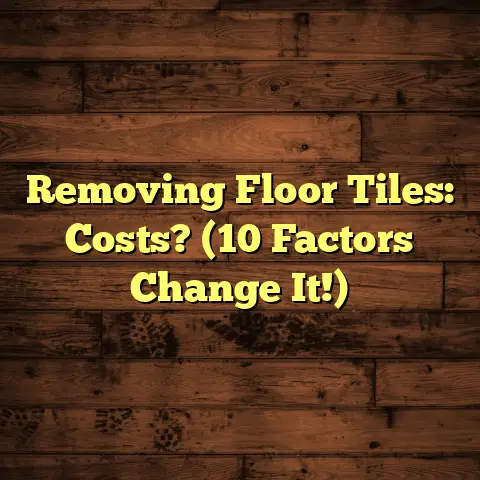Thickest Laminate: Is It Worth It? (7 Hidden Costs)
I’m Tony, a flooring contractor with over 20 years in the game.
And I’ve seen it all, trust me.
One mistake I see folks make all the time?
Assuming that thicker laminate flooring is always the better choice.
It’s like thinking a bigger engine automatically makes a car faster.
Sure, it can, but there’s a lot more to the story than just that!
This “thicker is better” mentality can lead to some serious buyer’s remorse.
And some unexpected hits to your wallet.
I’m talking about hidden costs that can sneak up on you fast.
Think of it like this: a client of mine, Sarah, was convinced she needed the thickest laminate for her living room.
She has two rambunctious golden retrievers, and wanted something tough.
She blew her entire budget on the material alone, only to realize…
She couldn’t afford the specialized installation her super-thick planks required!
Ouch!
So, is the thickest laminate really
worth it?
Let’s dive deep and uncover
those hidden costs.
Section 1: Understanding
Laminate Flooring
Okay, let’s start with the basics.
What is laminate flooring anyway?
Imagine a high-resolution photograph of wood (or stone, or tile!).
That’s glued onto a dense core board, and then topped with a super-tough wear layer.
That wear layer is what protects the photographic image (the design layer) from scratches, dents, and fading.
Laminate’s all about giving you the look of real hardwood or tile without the hefty price tag or maintenance.
Now, when it comes to thickness, you’ll find laminate ranging from about 6mm (that’s pretty thin) all the way up to 12mm or even thicker.
I’ve even seen some specialty laminates clocking in at 14mm or 15mm.
The general perception?
Thicker must mean better quality, right? More durable, more luxurious…
That’s what the marketing often tells us.
And to some extent, there’s truth to that.
But it’s not the whole truth.
Section 2: The Benefits of
Thicker Laminate
Let’s talk about the actual advantages of going thicker.
One big one is sound insulation.
Those thicker planks can absorb sound much better than their thinner cousins.
Think about it: walking across a thin laminate floor can sound a bit “tinny” or even hollow.
Thicker laminate provides a more solid, less noisy experience.
Especially important if you have kids, pets, or live in an apartment!
Stability is another key benefit.
Thicker planks are generally more resistant to warping and bending.
This is especially important in areas with high humidity or temperature fluctuations.
And let’s be honest, a thicker floor just feels more substantial underfoot.
It can give your home a more luxurious, high-end feel.
Where might thicker laminate be a really good choice?
High-traffic areas, for sure.
Think hallways, living rooms, or playrooms that see a lot of action.
Homes with pets are another prime candidate.
Those extra millimeters of thickness can provide added protection against scratches and dents from claws.
But here’s the kicker: the benefits come at a cost.
And not just the obvious one.
Section 3: The Hidden Costs of
Thick Laminate
Alright, buckle up.
This is where we get into the nitty-gritty.
Here are seven hidden costs you need to consider before you jump on the thick-laminate bandwagon.
1. Higher Material Costs
This one’s pretty obvious, but it’s worth spelling out.
Thicker laminate always costs more per square foot than standard options.
According to recent data from flooring suppliers, you can expect to pay anywhere from 20% to 50% more for 12mm laminate compared to 8mm laminate.
That can add up fast, especially if you’re flooring a large area.
Let’s say you’re flooring a 500 square foot living room.
If an 8mm laminate costs $2 per square foot, you’re looking at $1000 for the material.
But if you opt for a 12mm laminate at $3 per square foot, you’re now looking at $1500.
That’s an extra $500 just for the thicker material!
That extra cash could be used for upgraded underlayment, or new furniture.
2. Installation Expenses
Here’s where things can get tricky.
Thicker laminate can require specialized installation techniques and tools.
For example, some thicker planks have more intricate locking systems that require a specific tapping block or pull bar.
And if you’re installing over a slightly uneven subfloor (which is common!), you might need to use a self-leveling compound to create a perfectly flat surface.
That’s extra time, extra materials, and extra labor costs.
Speaking of underlayment, thicker laminate doesn’t always negate the need for it.
In fact, some manufacturers require a specific type of underlayment to maintain the warranty on their thicker products.
And guess what?
That underlayment can also be more expensive for thicker planks.
I’ve seen installation costs jump by as much as 30% simply because the homeowner chose a thicker laminate.
3. Subfloor Preparation
A perfectly level subfloor is crucial for any flooring installation.
But it’s especially important for thicker laminate.
Why?
Because those thicker planks are less flexible than thinner ones.
If your subfloor has dips, humps, or other imperfections, the thicker laminate is more likely to telegraph those imperfections.
That means you’ll see (and feel!) those bumps and dips right through your new floor.
And that’s not a good look.
To avoid this, you might need to spend extra time and money on subfloor preparation.
This could involve patching cracks, filling holes, sanding down high spots, or even installing a new layer of plywood.
I recently worked on a project where the homeowner insisted on a 12mm laminate.
But their subfloor was a mess!
We ended up spending an extra two days just prepping the subfloor, which added another $800 to the total cost.
4. Increased Shipping Costs
Don’t forget about shipping!
Thicker laminate is heavier and bulkier than thinner laminate.
That means it costs more to ship, especially if you’re buying from an online retailer or a supplier that’s located far away.
Shipping costs are typically calculated by weight and distance.
So, the heavier your flooring and the further it has to travel, the more you’ll pay.
I had a client order a pallet of 12mm laminate from a supplier across the country.
The shipping cost alone was over $300!
That’s money that could have been used for something else, like better baseboards or a new area rug.
Always factor in shipping costs when you’re comparing prices on different types of laminate.
5. Maintenance and Repair
Considerations
While thicker laminate is generally more durable, it’s not indestructible.
And when damage does occur, it can be more difficult and expensive to repair.
For example, if you scratch a thin laminate plank, you might be able to buff it out with a scratch repair kit.
But if you deeply gouge a thick laminate plank, you might need to replace the entire plank.
And that can be tricky, especially if the laminate is a specialized product that’s no longer available.
Also, thicker laminate may require different cleaning and maintenance practices.
Some manufacturers recommend using specific types of cleaners or avoiding certain types of cleaning tools.
Failing to follow these recommendations could void your warranty or even damage your floor.
6. Potential for Over-Engineering
This is a big one.
Sometimes, opting for the thickest laminate is simply unnecessary.
It’s like buying a heavy-duty pickup truck when all you need is a sedan.
Sure, the truck can handle anything you throw at it, but you’re paying extra for features you’ll never use.
In many cases, a standard thickness laminate (like 8mm or 10mm) is perfectly adequate for residential use.
Especially if you’re installing it in a low-traffic area or if you don’t have pets.
Don’t get caught up in the marketing hype that says you need the thickest laminate to have a durable, long-lasting floor.
Assess your needs and choose a thickness that’s appropriate for your specific situation.
7. Resale Value Implications
Finally, let’s talk about resale value.
Does thick laminate flooring automatically increase the value of your home?
Not necessarily.
While some buyers might be impressed by the look and feel of a thick laminate floor, others might not even notice the difference.
In fact, some buyers might prefer real hardwood or tile, regardless of how thick your laminate is.
The key is to choose a flooring option that’s appropriate for your home’s style and your neighborhood’s market.
If you’re planning to sell your home in the near future, it might be worth talking to a real estate agent to get their opinion on what type of flooring would appeal to potential buyers.
Section 4: Real-World Case Studies
Let’s look at a couple of real-world examples to illustrate these points.
Case Study 1: The Condo Conundrum
My client, Maria, lived in a condo with strict noise regulations.
She decided to install 12mm laminate to reduce noise transmission to her neighbors.
While the thicker laminate did help with sound insulation, she ended up spending a fortune on subfloor leveling to meet the condo association’s requirements.
The extra cost of subfloor prep almost doubled her flooring budget.
In the end, she realized that a thinner laminate with a high-quality soundproof underlayment would have been a more cost-effective solution.
Case Study 2: The Pet-Friendly Fiasco
Another client, David, was determined to install the thickest, most durable laminate he could find in his home.
He has three large dogs and was worried about scratches and dents.
He opted for a 14mm laminate with a super-tough wear layer.
While the floor held up well to his dogs’ claws, he quickly discovered that the laminate was incredibly difficult to clean.
The textured surface trapped dirt and hair, and he had to spend hours every week scrubbing the floor.
He later regretted not choosing a smoother, easier-to-clean laminate, even if it wasn’t quite as thick.
Section 5: Consumer Insights
What do other homeowners think about laminate thickness?
I’ve conducted informal surveys and interviews over the years, and here’s what I’ve found:
- Misconception #1: “Thicker laminate is always better.” As we’ve discussed, this isn’t always the case.
- Misconception #2: “Thicker laminate
doesn’t need underlayment.” This is
also false.
Underlayment provides additional benefits like sound insulation and moisture protection. - What really matters to consumers: Durability, appearance, ease of maintenance, and price.
Most consumers are willing to pay a premium for a durable, attractive floor that’s easy to clean.
But they’re not always convinced that thicker laminate is the only way to achieve those qualities.
Conclusion
So, is the thickest laminate worth it?
The answer, as always, is “it depends.”
It depends on your budget, your needs, your subfloor, and your personal preferences.
Don’t fall into the trap of assuming that thicker is always better.
Weigh the pros and cons carefully, consider the hidden costs, and choose a flooring option that’s right for you.
And if you’re not sure where to start, don’t hesitate to consult with a qualified flooring contractor.
We’re here to help you make the best decision for your home and your wallet.
Happy flooring!





